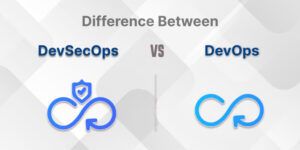
Explore the transformative power of DevSecOps Automation in the cloud era. Learn how automated security can safeguard your digital assets effectively.
Introduction
In today’s fast-paced digital landscape, the marriage of development, security, and operations has become more than just a strategic alliance; it’s a fundamental necessity. As institutions increasingly migrate their infrastructure and applications to the cloud, the vulnerabilities and threats they face multiply exponentially. This is where DevSecOps steps into the spotlight, offering a powerful solution to the evolving security challenges of the cloud era.
DevSecOps isn’t merely a buzzword; it’s a transformative approach that seamlessly weaves security into every software development and deployment phase. In this blog, we’ll explore how automatic security through DevSecOps is not just a trend but a critical imperative for safeguarding your digital assets in today’s cloud-centric world.
Understanding DevSecOps
DevSecOps, a portmanteau of Development, Security, and Operations, defines a paradigm shift in software development and deployment. It embodies a holistic approach to security by integrating it directly into the DevOps pipeline. Unlike traditional security models, which were often tacked on as an afterthought, DevSecOps promotes a proactive stance.
It encourages collaboration between developers and security teams from the outset, ensuring that security considerations are ingrained in the development process. Automated security testing, continuous monitoring, and quick reaction to susceptibilities are vital tenets. DevSecOps isn’t just about building software faster; it’s about building it more securely, aligning with today’s heightened cybersecurity demands.
The Significance of Cloud Computing
Cloud computing is a transformative force in the modern technological landscape, redefining how businesses and individuals access and utilize IT resources. Its significance lies in its capacity to deliver unprecedented scalability, flexibility, and cost-efficiency. Shifting data storage and processing to remote data centers liberates organizations from physical infrastructure constraints, fostering innovation and rapid deployment.
Moreover, cloud computing democratizes access to cutting-edge technologies, making advanced tools and services accessible to even small enterprises. Its shared responsibility model also underscores the paramount importance of security in the digital age, necessitating robust DevSecOps practices to safeguard sensitive data and applications.
Automation is the linchpin of current security procedures. It designates associations to notice, react to, and mitigate threats with unparalleled speed and accuracy. Automated security systems continuously monitor network traffic, swiftly identifying anomalies and potential breaches, far surpassing the capabilities of human operators alone.
The Role of Automation in Security
Furthermore, automation streamlines routine security tasks, reducing the risk of human error and allowing experts to focus on more complex challenges. Whether patch management, log analysis, or incident response, automation ensures that security measurements are always applied and adapted to evolving threats. It is indispensable in fortifying digital defenses in an increasingly dynamic and perilous digital landscape.
Integrating Security Early in the Development Lifecycle
Shifting security left in DevSecOps is critical for several reasons. Firstly, it enables proactive identification and mitigation of security vulnerabilities during the development phase, reducing the chances of costly breaches in production. Integrating security into the CI/CD pipeline with scanning tools automates the detection of vulnerabilities in code and dependencies, ensuring rapid feedback to developers.
By addressing security early, teams save time and resources compared to fixing issues post-deployment. Moreover, it promotes a security-aware culture within the development team and fosters collaboration between developers and security experts. Early security integration is the linchpin for building robust, secure software in today’s digital landscape. It’s a crucial step in devops security
Continuous Monitoring and Compliance
Continuous security monitoring is paramount in today’s dynamic threat landscape. It supplies real-time visibility into an organization’s IT environment, immediately detecting and responding to potential threats. DevSecOps leverages automation and integrates security tools into the development process, allowing for real-time monitoring of cloud resources and applications. This visionary strategy makes sure that security is an ongoing concern, not an afterthought.
Also Read: Top Amazing DevSecOps Tools: Tools Activities Guidebook
Moreover, compliance is pivotal in cloud security, aligning operations with industry rules and norms. By monitoring and adhering to compliance requirements, organizations mitigate risks, build customer trust, and avoid costly penalties, further underlining its critical significance in the cloud era. It’s a crucial step in devops security
Case Studies and Success Stories
Several organizations have achieved remarkable success with DevSecOps in the cloud. Take Netflix, for instance. They’ve seamlessly integrated security into their development pipeline, leveraging automated security testing to protect their vast cloud infrastructure and customer data.
Another standout is Capital One. They’ve embraced DevSecOps practices to fortify their cloud operations, detecting and remediating vulnerabilities swiftly. This approach helped them fend off a massive data breach, showcasing the efficacy of proactive security measures. It’s a great example of dev sec.
Similarly, Adobe’s adoption of DevSecOps improved its cloud security posture by automating security processes and ensuring the safety of its digital assets. These case studies underscore how DevSecOps bolsters security in the cloud era, safeguarding organizations from evolving threats. It’s a great example of dev sec.
Challenges and Best Practices
Implementing DevSecOps in the cloud presents unique challenges. One common issue is resistance to change within organizations, as it requires a cultural shift toward collaboration and automation. Integrating security tools into existing CI/CD pipelines can also be complex and time-consuming.
Promoting a culture of security awareness and providing adequate training is crucial to confound these challenges.
Implementing Infrastructure as Code (IaC) and automating security testing in the pipeline simplifies integration. Employing containerization and serverless architectures enhances security and scalability. Regularly revise security procedures, conduct threat modeling, and learn to stay ahead of growing hazards. These best practices empower organizations to navigate the DevSecOps journey in the cloud era successfully.
Also Read: Essential Practices To Improve Your Website Security
Future Trends in DevSecOps and Cloud Security
The future of DevSecOps and cloud security promises intriguing developments. Firstly, adopting AI and machine learning for threat detection and response is set to skyrocket, enhancing the ability to identify and mitigate sophisticated threats in real time. Additionally, the rise of serverless computing and containerization will demand new security approaches.
devsecops security will evolve to incorporate even tighter security integration into every aspect of development and deployment. Automation will become more sophisticated, allowing for rapid remediation of vulnerabilities. The increasing complexity of cloud environments, compliance, and regulatory frameworks will drive innovation in security practices. In a constantly evolving threat landscape, devsecops security will adapt by becoming more agile, proactive, and integrated, ensuring robust cloud security in the years to come.
In conclusion, the concept of automatic security through DevSecOps has emerged as an indispensable guardian in the cloud era. It transcends being a mere buzzword, evolving into a fundamental strategy for organizations seeking to fortify their digital fortresses. DevSecOps streamline development processes and ensures security is at every endeavor’s forefront.
As cloud devsecops adoption surges, the imperative for automated security becomes more pronounced. By shifting security left, integrating robust scanning tools, and nurturing a culture of vigilance, businesses can confidently thrive in the cloud. In this dynamic landscape, DevSecOps is the key to unlocking the true potential of secure and agile cloud computing.
Also Read: DevSecOps vs. DevOps: What’s the different and Their Impact




![15 Appium Interview Questions and Answers for Freshers [2025] 15 Appium Interview Questions and Answers for Freshers [2025]](https://www.weetechsolution.com/wp-content/uploads/2024/09/Appium-Interview-Questions-and-Answers-for-Freshers-300x150.jpg)

